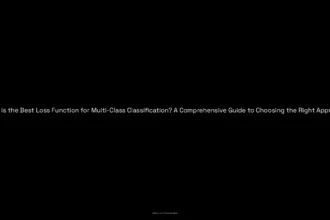Are you ready for an explosive ride into the world of gradients? Brace yourself, because we’re about to dive deep into the fascinating phenomenon of Gradient Explosion! Whether you’re a data scientist, a machine learning enthusiast, or just curious about the inner workings of algorithms, this blog post will unravel the mysteries behind this explosive phenomenon. Get ready to discover the causes, fixes, and types of Gradient Explosion, as well as the importance of Gradient Descent. So, fasten your seatbelts and prepare to embark on a thrilling journey through the explosive world of gradients!
Table of Contents
ToggleUnderstanding the Gradient Explosion Phenomenon
Picture a rocket soaring upwards, breaking through the atmosphere with growing, uncontrollable speed. This is akin to the phenomenon of gradient explosion in deep learning—a perilous ascent where calculation derivatives skyrocket, threatening the stability of our neural network. As we thread through the intricate layers of a model, the gradients (our navigational controls) can sometimes grow at an exponential rate. This surge in gradient magnitude leads to erratic learning loss and subpar training performance—classic hallmarks of a gradient explosion.
| Aspect | Detail |
|---|---|
| Definition | Multiplication of large derivatives causing exponential growth in gradients. |
| Primary Cause | Product of weights’ derivatives exceeding one in magnitude. |
| Identification | Poor model performance on training data, unstable learning loss. |
| Solution | Gradient clipping to prevent derivatives from surpassing a defined threshold. |
When we delve into the genesis of this issue, we unearth that the culprits are the weights within the neural network. Each weight’s gradient is tied to a sequence of factors—when these factors multiply to amounts greater than one, we stand on the precipice of a gradient explosion. Detecting this early is crucial. Signs of distress include the model’s lackluster performance on training sets and a volatile learning loss, which can swing wildly due to the disproportionate gradient updates.
To navigate away from this treacherous path, practitioners often employ gradient clipping. This technique involves putting a cap, a proverbial ceiling, on the value of gradients. By doing so, gradients are prevented from running amok during the weight update process, ensuring a smoother and more stable descent towards optimal model performance.
As we prepare to dive into the subsequent sections, we’ll explore the intricacies of causes, solutions, and the broader context of gradient problems in machine learning. Understanding gradient explosion is but the first step in mastering the art of training deep neural networks.
Causes of Gradient Explosion
Imagine a snowball rolling down a snowy mountainside. As it descends, it gathers more snow, growing exponentially in size. This imagery parallels the gradient explosion phenomenon in neural networks, where gradients accumulate in an uncontrolled manner during backpropagation. But what sets this perilous avalanche in motion within the layers of a neural network?
The root cause of gradient explosions is often misunderstood, leading some to mistakenly blame the activation functions. In reality, the true culprits are the weights within the neural network. Each weight is intricately connected to a gradient, which in turn is a product of multiple factors. When this product repeatedly contains values greater than one, the gradient begins to swell uncontrollably, much like our snowball gaining mass and momentum.
Consider a network with numerous hidden layers. Each layer’s output is used as the input for the subsequent layer, and during the backpropagation process, derivatives of these outputs (with respect to the weights) are calculated and multiplied together. If these derivatives are consistently large, the cumulative effect is a rapidly increasing gradient that inflates exponentially as it travels backwards through the network’s architecture – a classic case of the gradient explosion.
But how does this manifest in practical terms? Key indicators include erratic performance on training data and wildly fluctuating learning losses. These symptoms suggest that the gradients have become too large, leading to weight updates that overshoot the mark, destabilizing the learning process.
To grasp the severity of the issue, we must acknowledge the delicate balance required for neural networks to learn. Weights must be updated in a controlled manner, with gradients serving as the guide. When gradients explode, they drag the network’s performance down into a chasm of instability. It is a reminder that in the world of machine learning, excess can be as detrimental as deficiency.
In the following section, we will explore the practical solutions to this pressing issue, examining how gradient clipping can serve as a safeguard against the disruptive force of exploding gradients. As we continue our journey, we’ll see how this technique helps to keep the gradient snowball at a manageable size, ensuring that our neural network remains on a stable and productive path.
Fixing Gradient Explosion with Gradient Clipping
In the quest to tame the beastly phenomenon of gradient explosion, data scientists and machine learning engineers have developed a safeguard known as gradient clipping. Imagine, if you will, a train hurtling down a steep mountain at breakneck speed; gradient clipping acts like a set of robust brakes, ensuring the train slows down before any catastrophe. Similarly, this technique imposes a cap on the size of gradients to prevent them from growing out of control, much like setting a speed limit that keeps the train’s velocity in check.
During the intricate backpropagation process, when the gradients are computed, they are immediately inspected. If any gradients exceed the predetermined threshold, they are trimmed down to the maximum allowable value. This does not mean they are discarded or reduced to insignificance; rather, they are rescaled to a size that is both manageable and still reflects the direction in which the model should learn.
Integrating gradient clipping into the learning process is akin to adding a skilled navigator to the train’s crew. This navigator doesn’t change the destination but ensures that the journey is smooth and steady. By doing so, the gradients remain stable, the learning process becomes more reliable, and the neural network can safely reach the valleys of optimization, without the threat of careening off the tracks due to an overwhelming surge of gradient values.
Employing gradient clipping is a strategic move in the art of machine learning. It’s particularly essential when dealing with deep neural networks, where the layers are many and the risk of exponential gradient growth is high. By implementing this technique, the model’s performance becomes more predictable and the peril of catastrophic forgetting or erratic weight updates is significantly mitigated.
Moreover, gradient clipping is an approach that speaks to the elegance of simplicity in complex systems. Without the need for elaborate architectural changes or sophisticated algorithms, this technique can be seamlessly incorporated into existing training regimes. It stands as a testament to the power of straightforward solutions in the face of daunting challenges found within the realm of artificial intelligence.
Understanding the delicate balance of gradient flow is crucial for anyone venturing into the field of deep learning. With gradient clipping, we have a tool that not only prevents the explosion of gradients but also preserves the integrity of our models, ensuring that they learn robustly and effectively from the data they are exposed to.
As we continue to unravel the intricacies of neural networks, techniques like gradient clipping remain pivotal in our journey towards creating intelligent systems that can learn, adapt, and evolve. It’s through such methods that we harness the power of AI, steering clear of the pitfalls and soaring towards the pinnacle of machine learning excellence.
The Purpose of Gradient Descent
The quest to minimize a cost function lies at the heart of gradient descent, a cornerstone algorithm in the realm of machine learning. Much like a mountaineer meticulously choosing a path to safely descend a steep cliff, gradient descent is the methodical process through which a machine learning model calibrates its parameters to find the most optimal solution.
Imagine navigating through a dense fog in a hilly terrain, seeking the lowest valley. Your senses are heightened as you feel the ground beneath you—each step is a decision, a guess, informed by the subtle slopes you perceive. This is the essence of gradient descent in the world of data. In this scenario, the fog represents the unknowns within the vast datasets, the hilly terrain symbolizes the complex cost function landscape, and the lowest valley is the coveted global minimum that offers the best model performance.
At every iteration, gradient descent evaluates the gradient—the steepness of the terrain—and takes a step proportional to the negative of the gradient. This is akin to descending a hill by moving in the direction that seems steepest at your current location, hoping it leads you closer to the bottom. The size of these steps, known as the learning rate, is crucial: too large a step can overshoot the target, while too small a step can prolong the journey unnecessarily.
In the context of machine learning, the cost function measures the discrepancy between the model’s predictions and the actual outcomes. It’s the numerical manifestation of error, a beacon that guides the model’s adjustments. By minimizing this error, the model enhances its predictive prowess, thereby becoming more adept at the tasks it is designed to perform.
Gradient descent is not just a single algorithm but a family of algorithms, each with its own strengths, tailored to different kinds of problems and datasets. Some descend with the momentum of accumulated past gradients, some adaptively adjust their step sizes, and others take into account the curvature of the cost function landscape. Regardless of their differences, they all share the same objective: to guide the model toward the most accurate predictions by traversing the cost function’s surface as efficiently as possible.
This relentless pursuit of optimization is not without its pitfalls, as the preceding sections have highlighted. The peril of gradient explosions looms over the process, threatening to derail the model’s learning by leading it astray with oversized steps. Hence, techniques like gradient clipping act as safety harnesses, ensuring that even if the gradient swells, the model remains anchored and continues its descent safely.
As we step into the next section, the narrative of our journey through the treacherous terrains of training deep neural networks continues. We will delve into the shattered gradients problem, a phenomenon that can obscure the path to optimization, much like a sudden storm can obliterate a climber’s view of the mountain pass. But just as climbers find their way through the tempest, so too do machine learning practitioners employ innovative strategies to navigate around these obstacles.
The Shattered Gradients Problem
Imagine a world where echoes fade into a cacophony rather than providing clear direction. This is akin to the challenge of shattered gradients that deep learning practitioners face. In the realm of neural networks, particularly as the depth of standard feedforward networks increases, an issue arises similar to echoes losing their clarity—gradients start to resemble a chaotic burst of white noise.
Why is this problematic? Gradients are the compass that guide the optimization process, pointing the way to lower loss. But when gradients become scattered and diffuse, they lose their ability to direct the learning process effectively. The consequence is a training journey fraught with confusion, where the path to convergence is obscured, and progress towards the model’s goal is stymied.
However, Residual Networks (Resnets) shine a beacon of hope on this problem. Resnets introduce shortcuts that allow gradients to flow through the network more freely. These architectural innovations significantly reduce the tendency of gradients to shatter, much like a lighthouse cuts through fog, offering clearer navigation for the training process.
With Resnets, each layer has the opportunity to learn from a more unadulterated signal, allowing for deeper networks without the cacophony of shattered gradients. Leveraging such architectures, deep learning models can be trained more effectively and efficiently, reaching new heights of performance that were once hindered by the limitations of gradient noise.
As we delve deeper into the intricacies of neural network optimization, it becomes clear that the solution to the shattered gradients problem is not just a technical fix but a strategic architectural choice. The introduction of Resnets is a testament to the ingenuity in overcoming such hurdles, reminding us that the field of deep learning is as much about creative problem-solving as it is about mathematics and code.
The journey through the foggy landscape of model training is daunting, but with tools like Resnets, we forge a path towards clarity and precision. As we continue to explore the nuances of gradient-based optimization, we shall see that the shattered gradients problem, while formidable, is but one of many challenges that can be overcome with the right combination of innovation and understanding.
Overcoming Vanishing and Exploding Gradient Problems
Deep within the neural labyrinths of deep learning, the notorious beasts of vanishing and exploding gradients lurk, ready to derail the training of even the most sophisticated models. For AI practitioners, the battle against these gradients is as strategic as it is technical. The most direct strategy to tackle this issue is as elegant as it is effective—altering the very DNA of neural networks, their activation functions.
Embracing the Power of ReLU
The evolution of activation functions brought forth a champion—the Rectified Linear Unit, or ReLU. Its simplicity is its strength: for any positive input, it outputs the same value, and for any negative input, it outputs zero. This linear relationship for positive values means that, as long as the input is positive, the gradient remains constant, preventing the undesirable effects of vanishing and exploding gradients.
By making this tactical switch from the traditional sigmoid activation function to ReLU, one can significantly improve the flow of gradients during backpropagation. This seemingly small shift is a giant leap for network training efficiency. The benefits of ReLU extend beyond just preventing gradient issues—it also accelerates the convergence of stochastic gradient descent, as networks learn faster with ReLU compared to their sigmoid counterparts.
Alternatives on the Horizon
However, the realm of activation functions is vast and varied. Variants of ReLU, such as Leaky ReLU and Parametric ReLU, offer nuanced advantages, allowing a small, positive gradient when the input is negative. This tweak ensures that no neuron is left inactive, which can be a limitation in the standard ReLU function.
While the choice of activation function is a potent weapon against the vanishing gradient problem, it is not the only one in our arsenal. Techniques such as careful weight initialization and batch normalization also play pivotal roles. Weight initialization methods like He or Xavier initialization set the stage for a stable learning process, while batch normalization standardizes the inputs to a layer, reducing the internal covariate shift and improving the stability of the neural network.
For those instances where gradients threaten to explode, the technique of gradient clipping comes to the rescue. By capping the gradients during backpropagation, this method ensures that they do not spiral out of control, allowing the optimization process to proceed smoothly.
In the grand tapestry of deep learning, the choice of activation functions and the use of these additional techniques are like the threads that strengthen the fabric, enabling the creation of deeper and more robust neural networks. As we continue our journey through this article, let us keep in mind that the quest to conquer vanishing and exploding gradients is an ongoing one, with each solution weaving a new layer of possibility into the future of AI.
Types of Gradient Descent
In the pursuit of the most efficient path to train neural networks, understanding the various flavors of gradient descent is akin to selecting the right vessel for a treacherous sea voyage. Each type of gradient descent algorithm navigates the choppy waters of optimization with distinct strategies, offering a unique blend of speed, accuracy, and efficiency. In this section, we will explore the three primary methods that data scientists employ to steer their neural networks toward convergence: Batch Gradient Descent, Stochastic Gradient Descent, and Mini-Batch Gradient Descent.
Batch Gradient Descent
The most classical form of the algorithm, Batch Gradient Descent, processes the entire training dataset to compute the gradient of the cost function. Picture a meticulous cartographer plotting every contour of the landscape before taking a single step. This method ensures a steady and assured direction toward the minimum of the cost function, as it considers the global perspective of the data. However, this meticulousness comes at a cost—computational intensity—especially with large datasets, leading to time-consuming iterations.
Stochastic Gradient Descent
At the other end of the spectrum is Stochastic Gradient Descent (SGD). Imagine a daring explorer choosing to take a step forward after surveying just a single point in the terrain. SGD updates parameters for each training example, one at a time. This approach can be noisy and erratic, resembling the unpredictable gusts of wind at sea. Yet, this very randomness can be a boon; it allows SGD to escape the entrapment of local minima, potentially finding better solutions more quickly than its batch counterpart. This method is often preferred when dealing with enormous datasets or when rapid convergence is favored over precision.
Mini-Batch Gradient Descent
Charting a middle course is Mini-Batch Gradient Descent, the navigator who groups observations into small clusters, plotting a path using these representative samples. By updating parameters on subsets of the training data—typically ranging from 10 to a few hundred examples—this method marries the computational efficiency of batch processing with the stochastic nature of SGD. It’s a balanced approach, avoiding the capriciousness of SGD while maintaining a more responsive and faster convergence than full batch processing. Mini-batches allow the model to update more frequently, refining its course with each small batch, and are well-suited for parallel processing in modern computing architectures.
These gradient descent algorithms are not one-size-fits-all solutions but rather tools to be selected based on the specific challenges and requirements of each deep learning journey. As we navigate forward, we will delve deeper into the intricacies of these methods and how they can be fine-tuned to address the notorious issues of vanishing and exploding gradients, ensuring that our neural networks reach their destination effectively and efficiently.
Q: What is gradient explosion?
A: Gradient explosion refers to the problem where the gradient in a neural network increases exponentially as it propagates down the model, eventually leading to unstable learning.
Q: What causes gradient explosion?
A: Gradient explosion is caused by the weights in the neural network. If the product of the derivatives linked to each weight is greater than one, there is a possibility that the gradients become too large.
Q: How can a gradient explosion be detected?
A: There are a few key indicators of gradient explosion. One is that the model is not performing well on the training data. Another is the presence of large changes in the learning loss, indicating unstable learning.
Q: How can gradients exploding be fixed?
A: One effective way to prevent gradients from exploding is to use gradient clipping. This involves capping the derivatives to a certain threshold and using the capped gradients to update the weights throughout the network.





